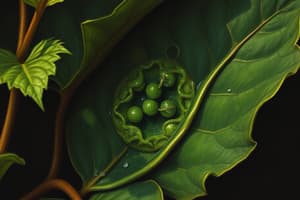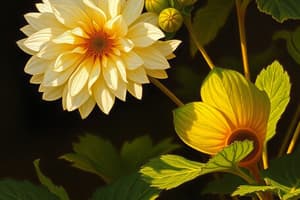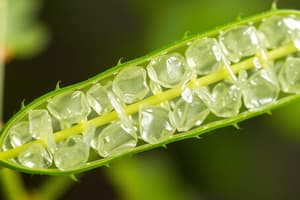Podcast
Questions and Answers
What is the main function of chlorophyll in chloroplasts?
What is the main function of chlorophyll in chloroplasts?
- To provide structural support to plant cells
- To produce glucose from sunlight
- To convert carbon dioxide into oxygen
- To capture sunlight energy for photosynthesis (correct)
Which of the following statements about heterotrophs is correct?
Which of the following statements about heterotrophs is correct?
- Heterotrophs contain chloroplasts for photosynthesis.
- Heterotrophs are found only in aquatic environments.
- Heterotrophs rely on autotrophs for their food source. (correct)
- Heterotrophs can synthesize their own food using sunlight.
What are the two main regions of a chloroplast and their respective functions?
What are the two main regions of a chloroplast and their respective functions?
- Outer membrane for gas exchange and inner membrane for nutrient absorption
- Stroma for dark reactions and grana for light reactions (correct)
- Stroma for light reactions and grana for dark reactions
- Grana for glucose production and stroma for oxygen release
What byproduct is released as a result of photosynthesis?
What byproduct is released as a result of photosynthesis?
Which of the following correctly describes chloroplasts?
Which of the following correctly describes chloroplasts?
Flashcards
Heterotrophs
Heterotrophs
Organisms that obtain energy by consuming other organisms. They cannot produce their own food.
Autotrophs
Autotrophs
Organisms that make their own food using sunlight, carbon dioxide, and water. This process is called photosynthesis.
Photosynthesis
Photosynthesis
The process by which plants and other organisms convert light energy from the sun into chemical energy in the form of glucose. This process involves using carbon dioxide and water, releasing oxygen as a byproduct.
Chloroplasts
Chloroplasts
Signup and view all the flashcards
Chlorophyll
Chlorophyll
Signup and view all the flashcards
Study Notes
Photosynthesis Overview
- Photosynthesis converts solar energy into chemical energy in autotrophs.
- Heterotrophs rely on external food sources.
- Not all sunlight energy is converted to glucose.
- Enough energy is produced to support heterotrophs.
Photosynthesis Process
- Photosynthesis uses carbon dioxide and water in the presence of sunlight and chlorophyll.
- The process produces glucose, releasing oxygen as a byproduct.
- This happens in the green parts of plants (stems, leaves, flowers).
Chloroplast Structure
- Chloroplasts are disc-shaped, green plastids found in plant cells.
- They have two membranes.
- The stroma is the fluid-filled region, where dark reactions occur.
- Grana are stacks of thylakoids, where light reactions happen.
- Chlorophyll enables light absorption for photosynthesis.
- Chlorophyll gives plants their green color.
- Chloroplasts reside in the mesophyll cells of leaves.
Studying That Suits You
Use AI to generate personalized quizzes and flashcards to suit your learning preferences.




